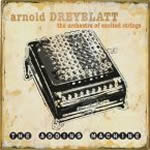|
|
 |
Dusted Reviews
Artist: Arnold Dreyblatt and The Orchestra of Excited Strings Album: The Adding Machine Label: Cantaloupe Review date: Mar. 31, 2002 |

|
|
|
 |
The penning of conceptual album titles is a tricky affair. Many musicians deserve a provisional (read: revocable) license for the attempt, while others manage to flex sufficient synaesthetic muscle to make the medium work. On his new release The Adding Machine, Arnold Dreyblatt, whose own career has stretched across several fields of the media arts spectrum, proves himself worthy of such metaphorical capacity. The five pieces successfully reinvent the mechanical aesthetic of a roaring human infrastructure, and it is this marriage, of the human and the concrete, that engenders in the material a post-industrial romance evident throughout Dreyblatt’s recorded output. The new record brings synthesis and juxtaposition to the minimalist canon, as the Orchestra of Excited Strings creates a sprawling and diverse atmosphere, which nonetheless remains consistent with the forebears of the movement.
A composer of stature, Dreyblatt has charted his own unique course in modern classical music. Often characterized as the most rock-oriented of American minimalists, his work with the Orchestra of Excited Strings does justice to the moniker, in as much as the paradox is even feasible. There is a driving force to The Adding Machine, with nods to blues and rock traditions, and melodic progression is evident throughout, if heavily syncopated. Still, tempo changes and stubborn breakbeats are primarily responsible for the shifting pace within the pieces, which could only sufficiently be described as joltingly ambient. The tone is militant but never abrasive, the seemingly rigid instrumental elements of the ensemble quickly giving way to the slipstream of their own ephemera in the manner of a lulling kaleidoscopic vision.
There is a decidedly oriental feel throughout The Adding Machine, but an eastward orientation is likely the fated direction of any ensemble to employ a thumbnail zither. Most minimalist endeavors, and particularly those of the New York school, from which Dreyblatt himself emerged, have traversed a similar path. String instruments, with their unique capacity for sustained drone, laid the foundation for the work of La Monte Young and Tony Conrad; the accomplishment, however, was not merely the aural byproduct of the means of production. Minimalism derives substance from the same metaphysics as those underscoring eastern philosophy: continuity, cohesion, singularity of vision. The Adding Machine, which opts for staccato plucking and percussion over extended drone, maintains this oriental mentality; the music builds and descends, but remains diachronically infinite, static in a mood suggestive of a peaceful, cyclical calm.
The material comprising The Adding Machine was initially prepared for a series of live performances, and while I was not fortunate enough to witness the debut at Tonic in January of 2001, I did manage to hear a live broadcast of the ensemble’s concert at the Brooklyn Museum of Art. So far as the memory of this vicarious experience remains accessible, there is a subtle magic to these compositions in their original context, contingent on the control and spontaneity of the performers. The Adding Machine provides an experiential blueprint for minimalist theory and ambient music in general, capturing this intoxicating atmosphere for its audience.
By Tom Roberts
|







